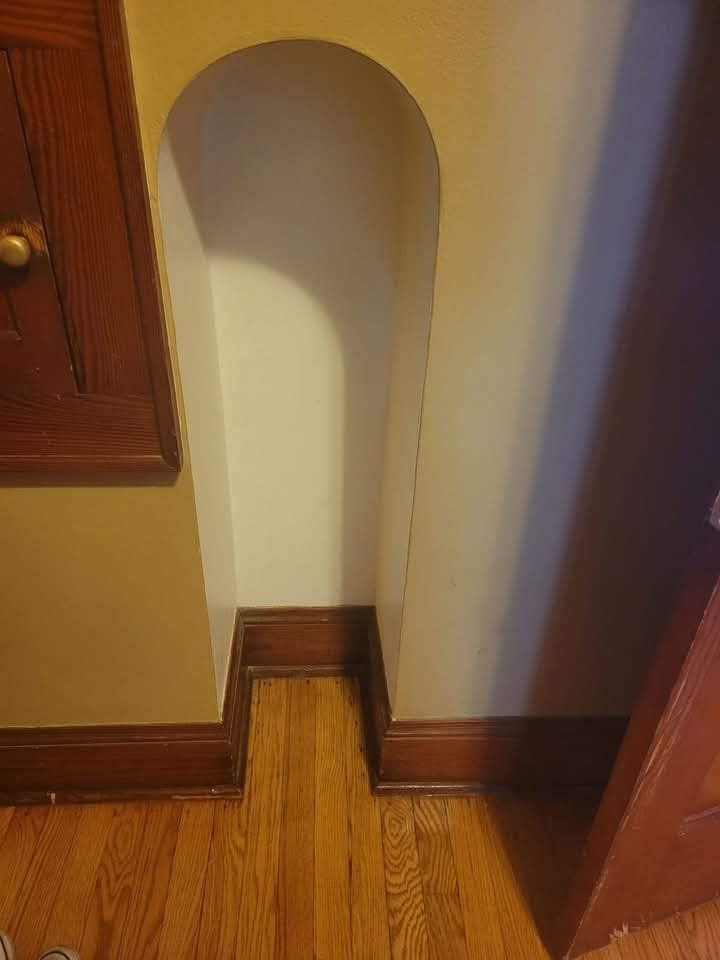When I first moved into my 1940s-era house a couple of years ago, one odd little detail immediately caught my attention—a strange, small nook in the hallway. It wasn’t deep or tall, probably around three feet high with a cute little peak at the top, almost like it had ambitions of being something important.

I stood there staring at it for a solid five minutes, totally puzzled. What could this possibly be for? It was too small to be a bookshelf, too awkwardly shaped to hold a vase (trust me, I tried and failed), and too random to just be decor. For months, it remained totally empty, a silent corner that seemed to mock me every time I passed it, daring me to figure it out. Then, one day while scrolling through an online forum dedicated to old homes, I stumbled on a post that made my jaw drop. Someone had uploaded a photo of a nearly identical nook—same shape, same dimensions—and inside it sat a rotary phone.
That was it. Lightbulb moment. It was a telephone niche. Suddenly, everything made sense. Back in the day, before smartphones and even cordless phones were a thing, households usually had just one phone. It was fixed in place, usually in a central location like a hallway, and everyone used it. These built-in telephone nooks were the original in-home communication stations. They sometimes had little shelves underneath for phone books or notepads, and maybe even a tiny light fixture above for nighttime calls. It was where moms wrote grocery lists while chatting, where teens whispered sweet nothings after curfew, and where everyone in the family practiced their best “Tell them I’m not home!” lines. It was basically the nerve center of home communication, and somehow I’d ended up with one preserved right in my hallway. Once I knew what it was, I couldn’t ignore it anymore. I had to do something.
I briefly considered hunting down an actual rotary phone, but those things are more expensive than you’d think. So instead, I leaned into the nostalgia without fully jumping back to the 1950s. I found an adorable reproduction phone in mint green that matched my kitchen tiles—yes, I absolutely color coordinated—and snagged a little vintage shelf from a thrift store for five bucks. I topped it all off with a faux leather notepad and a cute little “Call Mom” sign I found on Etsy.
And let me tell you, people notice. Every time someone comes over, they comment on that niche. One friend said, “This is like something out of my grandma’s house—but way cooler,” which, honestly, felt like the ultimate compliment. If you happen to have one of these odd little architectural leftovers in your home, don’t let it go to waste. There are so many fun ways to bring it back to life. You could go all in on the retro vibe with a real rotary phone and recreate the full mid-century look. Or maybe add a shelf and install a small spotlight to showcase vintage books or family heirlooms. You could switch things up with the seasons—pumpkins and mini scarecrows in fall, fairy lights in December, Easter eggs in spring. If you’re into tech, hide a charging station in there and make it a clever little USB hub. Or turn it into a tiny art gallery with framed prints or a handmade collage. The point is, there’s no wrong way to do it—just don’t ignore it. These niches are little historical gems, built into the walls of older homes, each one quietly telling a story. What’s funny is that for the longest time, I ran past that nook without giving it a second glance. It was background noise, just part of the wall. Now, it’s something special. A reminder that homes used to be built with quirks and purpose. A time when even something as everyday as a phone had its own designated spot. Sure, maybe it’s just a recessed hole in the wall, but to me, it’s a tribute to a simpler time when conversations didn’t involve scrolling, and people had to stay in one place just to make a call. I’m not giving up my iPhone anytime soon, but embracing a little vintage charm in that telephone nook? That’s definitely staying.





